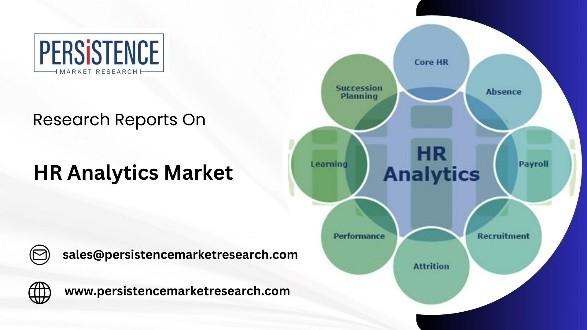Asia Pacific Emerges as Fastest-Growing HR Analytics Market
The HR analytics market is poised for significant growth, with a promising CAGR of 12.4% from 2022 to 2032. Valued at US$ 2.8 billion in 2022, it is expected to reach US$ 9 billion by 2032. The market previously experienced a higher CAGR of 13.7% from 2016 to 2021, resulting in a market size of US$ 2.5 billion in 2021. The growing demand for HR analytics solutions is driven by the integration of cutting-edge technologies and an expanding global workforce. These systems simplify complex HR processes, such as talent acquisition, retention, and employee engagement, by leveraging advanced tools for data segmentation and management.
Despite the challenges posed by the COVID-19 pandemic, which disrupted global markets and supply chains, the HR analytics market experienced minimal adverse effects. The shift to remote work during the pandemic accelerated the adoption of HR analytics tools, helping organizations streamline recruitment and HR practices while ensuring better connectivity between employees and HR departments. The pandemic underscored the need for effective HR management tools, particularly in sectors like IT, e-commerce, and software management, which benefit from enhanced work-life balance and better operational structures.

The global HR analytics market is undergoing significant transformation, with Asia-Pacific (APAC) emerging as the fastest-growing region. Driven by rapid digital transformation, the expansion of technology adoption, and a competitive need for data-driven decision-making, businesses across APAC are increasingly turning to HR analytics to manage their workforce more efficiently, improve employee performance, and enhance organizational effectiveness. With a compound annual growth rate (CAGR) of 12.4%, the HR analytics market in the region is projected to surge, making APAC a key player in the global HR tech landscape.
In this article, we explore why Asia-Pacific is emerging as the fastest-growing market for HR analytics, the factors fueling this growth, and the region’s role in shaping the future of HR practices globally.
Why Asia-Pacific is Leading the Charge in HR Analytics Adoption
Several factors contribute to the rapid growth of the HR analytics market in Asia-Pacific, making it the most dynamic region for HR tech innovation.
1. Rapid Economic Growth and Industrialization
APAC is home to some of the world’s fastest-growing economies, such as China, India, Japan, South Korea, and Southeast Asian nations. As these countries continue to industrialize and modernize,
For example, HR departments can work closely with finance teams to better understand the costeffectiveness of various talent acquisition strategies or assess the ROI of employee training programs. This alignment between HR and other business units ensures that HR strategies are aligned with broader organizational goals.
Challenges in the APAC HR Analytics Market
While the HR analytics market in Asia-Pacific is experiencing rapid growth, there are still several challenges that businesses must overcome.
1. Data Privacy and Security Concerns
Data privacy and security concerns remain a significant challenge in the region, especially with the varying data protection regulations in different countries. As HR analytics involves the collection and analysis of sensitive employee data, businesses must ensure that they adhere to local regulations and implement robust security measures to protect this data from cyber threats.
Countries like Singapore, Australia, and Japan have stringent data protection laws, and businesses must invest in compliance strategies to mitigate risks associated with data breaches and privacy violations.
2. Skill Shortage and Lack of Expertise
Despite the growing interest in HR analytics, there is still a shortage of skilled professionals who can analyze and interpret data in many APAC countries. The need for HR data scientists and analysts is outpacing supply, making it difficult for companies to fully leverage the potential of HR analytics.
To address this, businesses are investing in training and upskilling their HR teams, while also hiring external consultants and vendors who specialize in HR analytics. However, the lack of in-house expertise remains a significant barrier to widespread adoption.
3. Cultural Resistance to Data-Driven Decision-Making
In some APAC countries, especially those with deeply rooted traditional business cultures, there may be resistance to adopting data-driven HR strategies. Leaders and HR professionals who have relied on intuition and experience may be hesitant to trust data over established methods.
Overcoming this cultural resistance requires education, advocacy, and demonstrating the tangible benefits of using data to drive HR decisions. As more businesses in APAC see the success of their peers who have embraced HR analytics, this resistance is likely to diminish over time.
Conclusion
Asia-Pacific is rapidly emerging as the fastest-growing HR analytics market globally. The region’s economic growth, technological advancements, and workforce management challenges are driving businesses to adopt data-driven solutions to enhance talent acquisition, employee performance, and retention. As HR analytics continues to evolve with new technologies such as AI, machine learning, and cloud computing, APAC is positioning itself as a leader in the global HR tech industry.
While challenges such as data privacy concerns, skill shortages, and cultural resistance remain, the rapid pace of digital transformation in APAC countries suggests that these obstacles will be
overcome in the near future. As a result, the APAC region is poised to lead the global HR analytics market well into the next decade, shaping the future of work for businesses worldwide.
